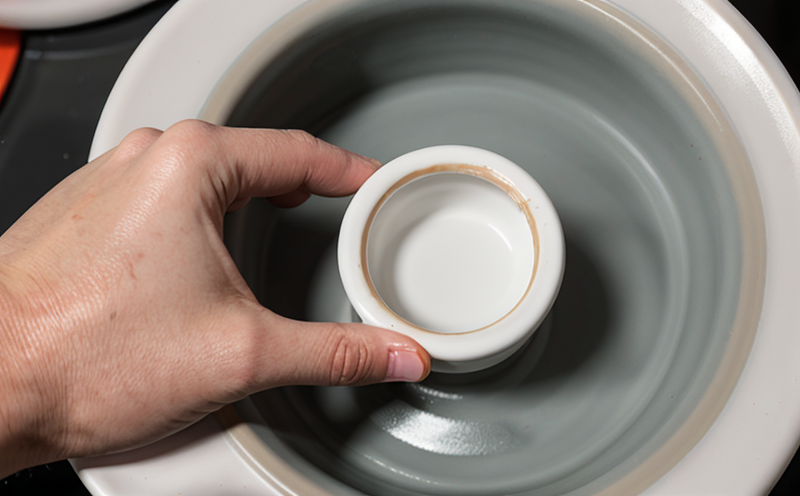ISO 23147 Compressive Strength of Advanced Ceramic Nanomaterials
The ISO 23147 standard provides a method for determining the compressive strength of advanced ceramic nanomaterials. This test is crucial in assessing the mechanical properties and structural integrity of these materials, which are widely used in sectors like aerospace, electronics, and biotechnology due to their exceptional hardness, thermal stability, and wear resistance.
Compressive strength testing ensures that materials meet quality specifications for reliability under high-stress conditions. For nanomaterials, this test is particularly important as they exhibit unique mechanical behavior compared to bulk ceramics. The ISO 23147 method allows for accurate measurement of compressive strength by applying a controlled force to the specimen until failure occurs.
The standard specifies detailed procedures for preparing specimens, conducting tests, and reporting results. Specimens are typically cut from larger ceramic nanomaterial samples using precise diamond saws or micromilling machines. The test setup involves placing the prepared specimen in a compression testing machine equipped with specialized fixtures to accommodate the small dimensions of nanostructured ceramics.
The testing process involves gradually increasing the load applied to the specimen until it reaches its breaking point. Throughout this process, force and displacement data are recorded at high precision using strain gauges and digital load cells. The compressive strength is then calculated based on the maximum load sustained by the specimen divided by its cross-sectional area.
Accurate measurement of compressive strength is essential for quality control in manufacturing processes. It helps ensure that materials meet critical design requirements, particularly when used in applications subject to high mechanical stress. For nanomaterials, this test provides insight into how these materials perform under extreme conditions, which is vital for their successful implementation.
The ISO 23147 standard ensures consistency and repeatability across laboratories worldwide by providing clear guidelines on specimen preparation, testing procedures, and data interpretation. This uniformity is critical in the global market where standards play a key role in ensuring interoperability between different manufacturers and suppliers of ceramic nanomaterials.
Understanding the mechanical behavior of nanostructured ceramics through compressive strength testing is fundamental for researchers and engineers working with these advanced materials. By adhering to ISO 23147, laboratories can provide reliable data that contribute to advancements in material science and engineering.
| Industry Applications |
|---|
| Aerospace: High-performance components like turbine blades Electronics: Ceramic capacitors and integrated circuits Biotechnology: Medical implants and diagnostic devices Automotive: Engine parts for enhanced durability |
Industry Applications
- Aerospace manufacturing, where advanced ceramics are used in high-stress components such as turbine blades.
- Electronics industry, particularly in the development of ceramic capacitors and integrated circuits that require precise mechanical properties.
- Biotechnology sector, for medical implants and diagnostic devices that must withstand rigorous conditions without degrading.
- Automotive manufacturing, where engine parts are engineered to enhance durability through the use of advanced ceramics.
Why Choose This Test
The ISO 23147 compressive strength test is essential for several reasons:
- Quality Assurance: Ensures that nanomaterials meet stringent quality standards and can withstand the mechanical stresses they will encounter in their applications.
- Innovation Support: Helps researchers develop new materials with improved properties by providing accurate data on material behavior under stress.
- Interoperability: Provides a common standard that allows manufacturers from different regions to produce compatible products, enhancing global supply chain efficiency.
- Certification: Facilitates the certification of materials as compliant with international standards, which is crucial for market entry and regulatory compliance.
This test plays a pivotal role in advancing nanotechnology by providing reliable data that can be used to improve material performance and durability. By adhering to ISO 23147, laboratories contribute significantly to the development of safer, more efficient products across various industries.
International Acceptance and Recognition
- The International Organization for Standardization (ISO) ensures that this standard is accepted worldwide.
- Compliance with ISO 23147 is recognized by regulatory bodies in numerous countries, facilitating easier market access.
- This test method is recommended by the European Committee for Standardization (CEN), ensuring compatibility with EU regulations.
- Adherence to this standard is also encouraged by the American Society for Testing and Materials (ASTM) as part of their material testing protocols.
The widespread adoption of ISO 23147 underscores its importance in the global nanotechnology community. Laboratories that perform this test can gain international credibility, enhancing their reputation among clients and partners.





